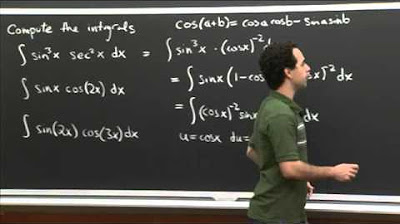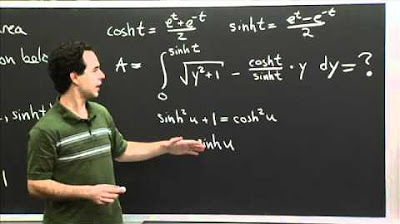Lec 28 | MIT 18.01 Single Variable Calculus, Fall 2007
TLDRIn this educational video, the professor delves into the technical aspects of trigonometric integrals and substitutions, essential for advanced calculus. Starting with a review of trig identities and derivatives, the lesson progresses to solving integrals involving secant and tangent functions. The professor illustrates the process of trig substitution to simplify complex integrals, particularly those with square roots of quadratic expressions. Examples include transforming expressions like √(1+x^2) and √(x^2-a^2) into more manageable trigonometric forms. The video concludes with a discussion on completing the square to handle more complex quadratics in integrals, showcasing the professor's expertise in simplifying and integrating challenging mathematical functions.
Takeaways
- 📚 The lecture is part of a series on trig integrals and trig substitutions, which are considered technical and useful for students.
- 🔍 The professor introduces trigonometric functions like secant and cosecant, and their relationships with sine and cosine, using the 'co' prefix to switch sine and cosine.
- 📈 The main trigonometric identity discussed is secant squared equals 1 plus tangent squared, which is fundamental to the lecture's integral calculations.
- 🧐 Derivatives of tangent and secant are calculated, leading to integrals of secant squared being tangent and integral of secant tangent being secant.
- 🔑 The concept of logarithmic derivatives is introduced, which is useful for integrating functions like secant.
- 📝 Examples of integrating more complex trigonometric polynomials are given, emphasizing the use of trig identities and substitutions.
- 🌐 The professor demonstrates how to integrate secant to the fourth power using substitutions and trig identities, resulting in an expression involving tan x and tan^3 x.
- ✅ The lecture includes a detailed walkthrough of a complex integral involving a square root of a quadratic expression, showcasing the process of trigonometric substitution.
- 🔍 The process of completing the square is introduced to simplify the integration of more complex square root expressions that do not fit standard forms.
- 📐 The use of right-angled triangles to understand and undo trigonometric substitutions is explained, helping to convert back to the original variable.
- 🎯 The lecture concludes with a summary of trigonometric substitutions and their usefulness in integrating expressions involving square roots of quadratics.
Q & A
What is the main topic discussed in the provided script?
-The main topic discussed in the script is the technique of trig integrals and trig substitutions in calculus, including the use of trigonometric identities and integrals involving secant and tangent functions.
Why did Professor Jerison decide to take a leave during the discussion on trig integrals?
-The script humorously suggests that Professor Jerison decided to take a leave because the topic of trig integrals and trig substitutions is the most technical part of the course.
What trigonometric identities are mentioned in the script?
-The script mentions several trigonometric identities, including secant squared being equal to 1 plus tangent, and the derivatives of tangent and secant in relation to secant squared and secant times tangent.
How is the integral of secant squared related to the tangent function?
-According to the fundamental theorem of calculus, the integral of secant squared with respect to x is equal to the tangent function, as the derivative of tangent is secant squared.
What substitution is suggested for the integral of tangent function?
-The substitution suggested for the integral of the tangent function is u = cos(x), which leads to du = -sin(x)dx, simplifying the integral to -ln|u| plus a constant.
How is the integral of secant tangent related to the secant function?
-The integral of secant tangent with respect to x is the secant function itself, as the derivative of secant is secant tangent.
What is the integral of secant of x in terms of natural logarithm?
-The integral of secant of x with respect to x is the natural logarithm of the expression sec(x) + tan(x), plus a constant.
How does the script use trigonometric identities to simplify the integral of sec^4(x)?
-The script uses the identity sec^2 = 1 + tan^2 to replace part of sec^4(x) with 1 + tan^2, allowing for a substitution of u = tan(x) and simplifying the integral to tan(x) + tan^3(x)/3 plus a constant.
What is the purpose of trig substitution in integral calculus?
-The purpose of trig substitution in integral calculus is to simplify complex integrals, especially those involving square roots of quadratic expressions, by converting them into more manageable trigonometric forms.
Can you provide an example of a trig substitution used in the script?
-An example of a trig substitution used in the script is when the integral of dx over x^2 times the square root of 1+x^2 is simplified by substituting x = tan(theta), which transforms the square root of 1+x^2 into sec(theta).
What is the process of 'completing the square' as mentioned in the script?
-The process of 'completing the square' is a method used to rewrite a quadratic expression in a form that allows for easier integration, especially when the expression is not in a simple form like a^2 - x^2 or a^2 + x^2.
How does the script illustrate the use of trigonometric identities in evaluating integrals?
-The script illustrates the use of trigonometric identities by showing how identities like sec^2 = 1 + tan^2 can be used to transform integrals into forms that are easier to evaluate, such as replacing sec^2 with 1 + tan^2 and then making appropriate substitutions.
What is the final answer to the integral of dx over x^2 times the square root of 1+x^2 after using trig substitution and completing the square?
-The final answer to the integral, after using trig substitution and completing the square, is the natural logarithm of (x+2)/2 plus the square root of (x^2 + 4x) over x, plus a constant.
Outlines
📚 Introduction to Trigonometric Integrals and Substitutions
The professor begins the lecture by acknowledging the source of the content under a Creative Commons license and encourages support for MIT OpenCourseWare. The main topic introduced is the integration of trigonometric functions, specifically focusing on sine and cosine integrals and the more complex secant and tangent functions. A table is presented to refresh the memory of these trigonometric functions and their relationships. The lecture aims to teach the technique of trigonometric integrals and substitutions, which is considered a technical part of the course, and starts with a review of basic trigonometric identities and their applications in calculus.
🔍 Derivatives and Integrals of Secant and Tangent Functions
The professor explains the process of deriving and integrating secant and tangent functions. The derivative of secant is shown to be secant times tangent, and the integral of secant squared is identified as tangent. Similarly, the integral of secant times tangent is found to be secant. The lecture also covers the integral of tangent, which is demonstrated through a substitution method, resulting in the natural logarithm of the absolute value of cosine. The professor emphasizes the importance of memorizing certain integral formulas for trigonometric functions.
🧩 Advanced Trigonometric Integrals and Substitution Techniques
The lecture continues with more complex integrals involving trigonometric polynomials and higher powers of secant. The professor uses trigonometric identities to simplify these integrals and introduces substitution techniques to manage integrals that cannot be solved directly. An example of integrating secant to the fourth power is given, where the identity secant squared equals one plus tangent squared is applied, followed by a substitution of u for tangent x, leading to a simplified integral that can be solved.
🌐 Trigonometric Substitutions for Complex Integrals
The professor tackles a challenging integral involving the square root of 1 plus x squared over x squared. A trigonometric substitution is suggested, where x is expressed as the tangent of theta, transforming the integral into a form involving secant. The substitution simplifies the integral into a form that can be solved by expressing all terms in sine and cosine, followed by another substitution involving u as sine of theta, leading to a solvable integral.
🔄 Undoing Trigonometric Substitutions
After solving the integral, the professor demonstrates how to revert back from the trigonometric substitution to the original variable. This process involves using the relationship between the trigonometric functions and the original variable x. The professor uses the example of converting the result involving cosecant of theta back into a function of x by utilizing the properties of a right-angled triangle and the definitions of tangent and secant in terms of x.
🎯 Completing the Square and Trigonometric Substitutions
The lecture concludes with a discussion on completing the square to handle integrals with more complex square roots of quadratic expressions. The professor illustrates how to transform a quadratic expression into a perfect square plus a constant, which can then be integrated using trigonometric substitutions. An example is given where the integral of dx over x squared plus 4x under the square root of the same expression is simplified by completing the square and then applying a substitution to solve the integral.
Mindmap
Keywords
💡Trigonometric Integrals
💡Trig Substitutions
💡Secant
💡Tangent
💡Derivative
💡Integral
💡Trigonometric Identity
💡Logarithmic Derivative
💡Completing the Square
💡Direct Substitution
Highlights
Introduction to trig integrals and trig substitutions as a technical part of the course.
Review of trigonometric functions secant, cosecant, tangent, and cotangent.
Explanation of the trigonometric identity secant squared equals 1 plus tangent.
Derivation of the derivative of tangent as secant squared.
Fundamental theorem of calculus applied to integral of secant squared.
Derivation and integration of secant tangent to secant.
Direct integration method for tangent function resulting in minus log cosine.
Integration strategy for secant of x using the derivative of secant plus tangent.
Technique of logarithmic derivative to simplify integration of secant.
General approach to integrate trigonometric polynomials using substitutions.
Integration of secant to the fourth power using trig identities and substitutions.
Discussion on the importance of practice in tackling polynomial trigonometric integrals.
Introduction to trig substitution in integrals for non-simple square roots.
Example of integrating a complex integral with square root of x^2 times the square root of 1+x^2 using trig substitution.
Use of trig identities to simplify square roots and facilitate integration.
Method of rewriting trig expressions in terms of sines and cosines for simplification.
Direct substitution technique demonstrated with integral of secant over tangent squared.
Process of undoing trig substitutions using right-angled triangle relationships.
Composite of trig function and inverse trig function computation game for deeper understanding.
Summary of trig substitutions for various integral forms and their usefulness.
Introduction to completing the square as a method to handle non-simple square root of quadratics in integrals.
Example of integrating a complex expression with square root of x^2 + 4x using completing the square and substitution.
Final walkthrough of undoing substitutions and returning the integral to terms of the original variable.
Transcripts
Browse More Related Video

Trig Integral Practice | MIT 18.01SC Single Variable Calculus, Fall 2010

Trig Substitution... How? (NancyPi)

Calculus Chapter 3 Lecture 23 Trig Substitution

Lec 27 | MIT 18.01 Single Variable Calculus, Fall 2007

Calculus 2 - Basic Integration

Hyperbolic Trig Sub | MIT 18.01SC Single Variable Calculus, Fall 2010
5.0 / 5 (0 votes)
Thanks for rating: